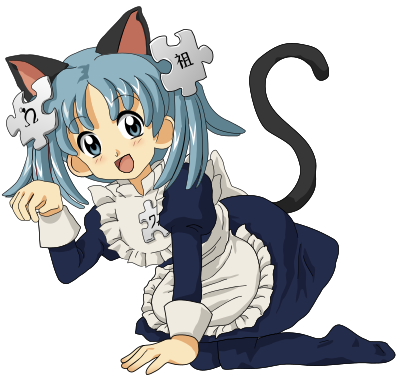
Search
Catgirl

A catgirl (猫娘, nekomusume) is a female kemonomimi character with feline traits, such as cat ears (猫耳, nekomimi), a cat tail, or other feline characteristics on an otherwise human body. They are not individuals who are literal cats but individuals who only look superficially feline. Catgirls are found in various fiction genres, particularly in Japanese anime and manga. Catboy is a term for the male equivalent of said character type.
History
The oldest mention of the term nekomusume comes from an 18th-century misemono (見世物) in which a cat/woman hybrid was displayed. Stories of shape-shifting bakeneko prostitutes were popular during the Edo period. The popularity of the nekomusume continued throughout the Edo and Shōwa periods, with many tales of cat/woman hybrids appearing in works such as the Ehon Sayoshigure (絵本小夜時雨) and Ansei zakki (安政雑記).
In Kenji Miyazawa's 1924 work, Suisenzuki no Yokka (水仙月の四日, literally The 4th of Narcissus Month) is the first modern day example of a beautiful, cat-eared woman. In 1936, the nekomusume experienced a revival in kamishibai. The first anime involving catgirls, titled The King’s Tail (Ousama no Shippo), was made in 1949 by Mitsuyo Seo. In America, the DC Comics character Catwoman first appeared in 1940, and Cheetah first appeared in 1943.
Catgirls were further made popular in 1978 manga series The Star of Cottonland, by Yumiko Ōshima. By the 1990s, catgirls were common in Japanese anime and manga. Catgirls have since been featured in various media worldwide. Enough of a subculture has developed for various themed conventions and events to be held around the world, such as Nekocon.
Reception
Japanese philosopher Hiroki Azuma has stated that catgirl characteristics such as cat ears and feline speech patterns are examples of moe-elements. Azuma argued that although some otaku sexual expression involves catgirl imagery, few otaku have the sexual awareness to understand how such imagery can be perceived as perverted. In a 2010 critique of the manga series Loveless, the feminist writer T. A. Noonan argued that, in Japanese culture, catgirl characteristics have a similar role to that of the Playboy Bunny in western culture, serving as a fetishization of youthful innocence.
See also
- List of catgirls and catboys
- Animal roleplay
- Moe anthropomorphism
- Nekomata
References
External links
- Media related to Catgirls at Wikimedia Commons
- The dictionary definition of catgirl at Wiktionary
Text submitted to CC-BY-SA license. Source: Catgirl by Wikipedia (Historical)
Articles connexes
- List of catgirls and catboys
- Princess Catgirl
- Catgirl (disambiguation)
- Teenage Catgirls in Heat
- Cashmere Cat
- Carrie Kelley
- Nekopara
- List of DC Comics characters: C
- Cat Girl Alliance
- Darkstalkers
- Margaret Qualley
- Cat Girl Manor
- Neko
- All Purpose Cultural Cat Girl Nuku Nuku
- Hentai
- Moe anthropomorphism
- Duela Dent
- The Dark Knight Strikes Again
- Robin (character)
- List of Nekopara episodes
Owlapps.net - since 2012 - Les chouettes applications du hibou


